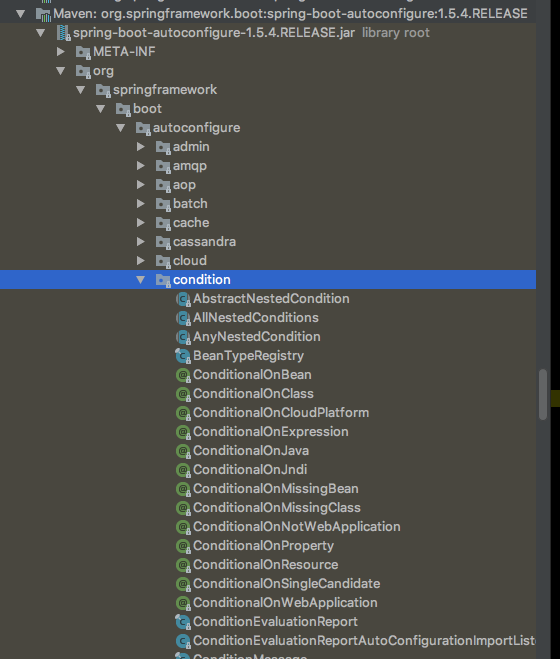
SpringBoot 的自动化配置让我们的开发彻底远离了 Spring 繁琐的各种配置,让我们专注于开发,但是SpringBoot 的自动化配置是怎么实现的呢?下面为你揭开 SpringBoot 自动化配置的神秘面纱。
SpringBoot 最为重要的一个注解就是 @SpringBootApplication,它其实是一个组合元注解:
@Target({ElementType.TYPE})
@Retention(RetentionPolicy.RUNTIME)
@Documented
@Inherited
@SpringBootConfiguration
@EnableAutoConfiguration
@ComponentScan(
excludeFilters = {@Filter(
type = FilterType.CUSTOM,
classes = {TypeExcludeFilter.class}
), @Filter(
type = FilterType.CUSTOM,
classes = {AutoConfigurationExcludeFilter.class}
)}
)
public @interface SpringBootApplication {
@AliasFor(
annotation = EnableAutoConfiguration.class,
attribute = "exclude"
)
// 此处省略部分代码
}
从这个注解可看出,它包含了 @EnableAutoConfiguration 这个注解,这个注解就是 SpringBoot 自动化配置原理的核心所在:
@Target({ElementType.TYPE})
@Retention(RetentionPolicy.RUNTIME)
@Documented
@Inherited
@AutoConfigurationPackage
@Import({EnableAutoConfigurationImportSelector.class})
public @interface EnableAutoConfiguration {
String ENABLED_OVERRIDE_PROPERTY = "spring.boot.enableautoconfiguration";
Class<?>[] exclude() default {};
String[] excludeName() default {};
}
我们发现它使用了 Spring 框架提供的 @Import 注解注入了注册 Bean 的配置类,在往下分析前,不妨先了解一下这个 @Import 注解,在我们平时使用 Spring 框架的 Enable* 类注解时,发现它们都有一个共同的特点,就是都有一个 @Import 注解,用来导入配置类,这些配置方式又分为三种类型:
@Import({xxxConfiguration.class})@Import({xxxSelector.class})@Import({xxxRegistrar.class})很明显,@EnableAutoConfiguration 这个注解使用的是第三种情况,导入 EnableAutoConfigurationImportSelector 类,继续跟踪源码:
public class EnableAutoConfigurationImportSelector extends AutoConfigurationImportSelector {
public EnableAutoConfigurationImportSelector() {
}
protected boolean isEnabled(AnnotationMetadata metadata) {
return this.getClass().equals(EnableAutoConfigurationImportSelector.class) ? ((Boolean)this.getEnvironment().getProperty("spring.boot.enableautoconfiguration", Boolean.class, true)).booleanValue() : true;
}
}
查看父类源码:
public String[] selectImports(AnnotationMetadata annotationMetadata) {
if (!this.isEnabled(annotationMetadata)) {
return NO_IMPORTS;
} else {
try {
// 此处省略部分代码
List<String> configurations = this.getCandidateConfigurations(annotationMetadata, attributes);
// 此处省略部分代码
return (String[])configurations.toArray(new String[configurations.size()]);
} catch (IOException var6) {
throw new IllegalStateException(var6);
}
}
}
protected List<String> getCandidateConfigurations(AnnotationMetadata metadata, AnnotationAttributes attributes) {
List<String> configurations = SpringFactoriesLoader.loadFactoryNames(this.getSpringFactoriesLoaderFactoryClass(), this.getBeanClassLoader());
Assert.notEmpty(configurations, "No auto configuration classes found in META-INF/spring.factories. If you are using a custom packaging, make sure that file is correct.");
return configurations;
}
我们最终发现它其实是实现了 ImportSelector 接口:
public interface ImportSelector {
String[] selectImports(AnnotationMetadata var1);
}
实现 ImportSelectors 接口的类通常与常规的 @Import 注解作用相同,它 的 selectImports() 方法返回的数组(类的全类名)都会被纳入到 Spring 容器中。
到这里,自动化配置幕后英雄终于出现了,它就是 Spring 的 SpringFactoriesLoader 类,该类专门用于加载 classpath下所有 JAR 文件的 META-INF/spring.factories 文件,不妨看看它的源码:
public static List<String> loadFactoryNames(Class<?> factoryClass, ClassLoader classLoader) {
String factoryClassName = factoryClass.getName();
try {
// 加载 spring.factories 中配置类的url
Enumeration<URL> urls = classLoader != null ? classLoader.getResources("META-INF/spring.factories") : ClassLoader.getSystemResources("META-INF/spring.factories");
ArrayList result = new ArrayList();
// 循环读取每个配置类路径
while(urls.hasMoreElements()) {
URL url = (URL)urls.nextElement();
Properties properties = PropertiesLoaderUtils.loadProperties(new UrlResource(url));
String factoryClassNames = properties.getProperty(factoryClassName);
result.addAll(Arrays.asList(StringUtils.commaDelimitedListToStringArray(factoryClassNames)));
}
return result;
} catch (IOException var8) {
throw new IllegalArgumentException("Unable to load [" + factoryClass.getName() + "] factories from location [" + "META-INF/spring.factories" + "]", var8);
}
}
我们去看看 spring.factories 到底长什么样子:

# Initializers
org.springframework.context.ApplicationContextInitializer=\
org.springframework.boot.autoconfigure.SharedMetadataReaderFactoryContextInitializer,\
org.springframework.boot.autoconfigure.logging.AutoConfigurationReportLoggingInitializer
# 此处省略部分配置
# Auto Configure
org.springframework.boot.autoconfigure.EnableAutoConfiguration=\
org.springframework.boot.autoconfigure.admin.SpringApplicationAdminJmxAutoConfiguration,\
org.springframework.boot.autoconfigure.aop.AopAutoConfiguration,\
org.springframework.boot.autoconfigure.amqp.RabbitAutoConfiguration,\
org.springframework.boot.autoconfigure.batch.BatchAutoConfiguration,\
# 此处省略部分配置
柳暗花明又一村,我们最终得出 SpringBoot 自动化配置要干的事情就是在启动过程中将 spring.factories 中相关的自动化配置类进行解析。
接下来我们就来分析自动化配置类:
Redis 官方的 RedisAutoConfiguration 配置类:
@Configuration
@ConditionalOnClass({JedisConnection.class, RedisOperations.class, Jedis.class})
@EnableConfigurationProperties({RedisProperties.class})
public class RedisAutoConfiguration {
public RedisAutoConfiguration() {
}
@Configuration
protected static class RedisConfiguration {
protected RedisConfiguration() {
}
@Bean
@ConditionalOnMissingBean(
name = {"redisTemplate"}
)
public RedisTemplate<Object, Object> redisTemplate(RedisConnectionFactory redisConnectionFactory) throws UnknownHostException {
RedisTemplate<Object, Object> template = new RedisTemplate();
template.setConnectionFactory(redisConnectionFactory);
return template;
}
// 此处省略部分代码
}
}
我们看到了 @ConditionalOnClass 和 @ConditionalOnMissingBean 这些注解,它们都是 SpringBoot的条件注解:

想要知道这些注解有什么功能,这里就不展开讲了,可以去查阅 SpringBoot 官方文档。以下主要是分析这些注解是如何进行工作的。
@ConditionalOnClass
@Target({ElementType.TYPE, ElementType.METHOD})
@Retention(RetentionPolicy.RUNTIME)
@Documented
@Conditional({OnClassCondition.class})
public @interface ConditionalOnClass {
Class<?>[] value() default {};
String[] name() default {};
}
可以看出,这些这些条件注解都组合了 @Conditional 元注解,只是使用了不同的条件,继续往下看 OnClassCondition 条件是如何工作的:
@Order()
class OnClassCondition extends SpringBootCondition implements AutoConfigurationImportFilter, BeanFactoryAware, BeanClassLoaderAware {
private BeanFactory beanFactory;
private ClassLoader beanClassLoader;
OnClassCondition() {
}
public boolean[] match(String[] autoConfigurationClasses, AutoConfigurationMetadata autoConfigurationMetadata) {
// 此处省略部分代码
}
// 此处省略部分代码
}
SpringBootCondition 实现了 Spring 的 Condition 接口,也就是并重写其 matche() 方法来构造判断条件。Condition 可以用于判断 Configuration 配置类需要满足什么条件才可以装进 Spring 容器。
当我们需要在 application.properties 中加入自定义的配置,那么 SpringBoot 是如何根据 application.properties 来实现自定义配置呢?我们往回看,发现了 @EnableConfigurationProperties({RedisProperties.class}) 这个注解,这个注解就是用来读取 application.properties 中对应的配置信息对应到 POJO 类当中:
RedisProperties.java
@ConfigurationProperties(
prefix = "spring.redis"
)
public class RedisProperties {
private int database = 0;
private String url;
private String host = "localhost";
private String password;
private int port = 6379;
private boolean ssl;
private int timeout;
private RedisProperties.Pool pool;
private RedisProperties.Sentinel sentinel;
private RedisProperties.Cluster cluster;
// 此处省略getter和setter
}
完。